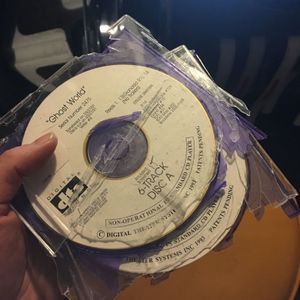| Welcome to Sprocket School! This project is maintained by volunteer editors. Learn more about how this works. |
DTS: Difference between revisions
No edit summary |
No edit summary |
||
| Line 1: | Line 1: | ||
DTS | '''DTS''' (Digital Theater Systems) can be thought of as a modern day incarnation of the Vitaphone "sound on disc" system. It uses a timecode, read by a timecode reader on the projector, to sync with a CD-Rom (or DVD) which is encoded with six channels: Left, Center, Right, Right Surround, Left Surround, and Low-Frequency Effects/Subwoofer. 70mm versions may have a different channel layout, most commonly "Special Venue" (Left, Left Extra, Center, Right, Right-Extra, and Surround) | ||
DTS is the only sound format used in modern 70mm prints. It is CRUCIAL that full run-throughs of 70mm prints with DTS tracks be done as there is no analog backup. | |||
DTS is | If you have a print with DTS discs, it is recommended that you do a test screening to make sure they will play back flawlessly. | ||
==Damage & how to avoid it== | |||
[[File:dts-smash.jpg|right|thumb|300px|DTS discs in smashed cases due to lack of proper packing material. ''Photo credit: [[User:Rlyon|Rlyon]]'']] | |||
Unlike [[Dolby Digital]] and other [[optical soundtrack]]s, DTS does not usually suffer from wear incurred from careless print handling (unless, for example, there is an emulsion scratch directly on the timecode), instead, DTS fails because of scratched or otherwise damaged DTS discs. Discs are often shipped in the same packing case or can as the film reels themselves, leading to smashed plastic cases and disc damage. This can be avoided by protecting the discs with a padded envelope or bubble wrap when preparing for shipping. If there's room in the shipping case, a 400 ft or 1000 ft film can be used for extra protection. | |||
==Missing discs== | |||
More often, a print will arrive without any DTS discs. | |||
Many collectors and archives treat original DTS discs with extreme care and do not use them for projection purposes. Instead, they make copies of the discs and use those, usually also saving them as ISO files and migrating them from time to time. This way, the original discs are handled as little as possible. | Many collectors and archives treat original DTS discs with extreme care and do not use them for projection purposes. Instead, they make copies of the discs and use those, usually also saving them as ISO files and migrating them from time to time. This way, the original discs are handled as little as possible. These collectors can also help you out — the [http://www.film-tech.com Film-Tech forums] are a good place to reach them, or contact info@sprocketschool.org | ||
==Historical information== | |||
The first film released in DTS was JURASSIC PARK (1993) | The first film released in DTS was JURASSIC PARK (1993) | ||
==External Links== | ==External Links== | ||
* [http://www.dts.com/ DTS, Inc. website] | * [http://www.dts.com/ DTS, Inc. website] | ||
Latest revision as of 09:42, 13 March 2019
DTS (Digital Theater Systems) can be thought of as a modern day incarnation of the Vitaphone "sound on disc" system. It uses a timecode, read by a timecode reader on the projector, to sync with a CD-Rom (or DVD) which is encoded with six channels: Left, Center, Right, Right Surround, Left Surround, and Low-Frequency Effects/Subwoofer. 70mm versions may have a different channel layout, most commonly "Special Venue" (Left, Left Extra, Center, Right, Right-Extra, and Surround)
DTS is the only sound format used in modern 70mm prints. It is CRUCIAL that full run-throughs of 70mm prints with DTS tracks be done as there is no analog backup.
If you have a print with DTS discs, it is recommended that you do a test screening to make sure they will play back flawlessly.
Damage & how to avoid it

Unlike Dolby Digital and other optical soundtracks, DTS does not usually suffer from wear incurred from careless print handling (unless, for example, there is an emulsion scratch directly on the timecode), instead, DTS fails because of scratched or otherwise damaged DTS discs. Discs are often shipped in the same packing case or can as the film reels themselves, leading to smashed plastic cases and disc damage. This can be avoided by protecting the discs with a padded envelope or bubble wrap when preparing for shipping. If there's room in the shipping case, a 400 ft or 1000 ft film can be used for extra protection.
Missing discs
More often, a print will arrive without any DTS discs.
Many collectors and archives treat original DTS discs with extreme care and do not use them for projection purposes. Instead, they make copies of the discs and use those, usually also saving them as ISO files and migrating them from time to time. This way, the original discs are handled as little as possible. These collectors can also help you out — the Film-Tech forums are a good place to reach them, or contact info@sprocketschool.org
Historical information
The first film released in DTS was JURASSIC PARK (1993)
External Links
- DTS, Inc. website
- Wikipedia: DTS